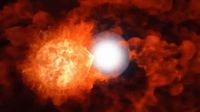The anticipation surrounding the potential eruption of the Blaze Star, also known as T Coronae Borealis, is reaching fever pitch. Jean Schneider of the Paris Observatory has made headlines with his latest predictions, suggesting that this elusive star might finally go nova on either March 27, 2025, or November 10, 2025. His predictions, published in the Research Notes of the American Astronomical Society in October 2024, are based on a careful examination of previous eruption dates and the orbital mechanics of this intriguing binary system.
The quest to predict stellar events isn’t an easy one. The Blaze Star is not just one star but a binary system comprising a white dwarf and a red giant. Historically, this unique star has erupted twice, once on May 12, 1866, and again on February 9, 1946. These eruptions occurred approximately 80 years apart, prompting astronomers to speculate that the next one could be due in the mid-2020s. So why are cosmic timelines so tricky? Simply put, predicting stellar eruptions involves interpreting patterns, and it appears this one is proving to be particularly elusive.
Schneider's deduction about the potential eruption dates hinges on the star's past brightness variations—specifically, its behavior before previous eruptions. For those keeping track, while the star showed signs of brightening and dimming leading up to its last eruption, waiting for the Blaze Star to explode involves considerable uncertainty. Will it erupt on March 27? Schneider expresses this uncertainty succinctly: "Will the Blaze Star finally explode on March 27, 2025? Or maybe it’s November 10, 2025?" Ultimately, one can only observe and speculate.
For the star-gazers out there, the Blaze Star is a captivating target nestled within the constellation Corona Borealis, also known as the Northern Crown. However, its visibility depends greatly on two factors: the time of year and whether it actually erupts. The constellation appears somewhat like a backward ‘C’ and is positioned between the bright orange star Arcturus and the quadrilateral shape of Hercules. The star is typically too faint to be seen with the naked eye but could shine brightly alongside Alphecca, the most prominent star in the constellation.
What makes the upcoming nova particularly enticing is its expected brightness. Astronomers believe that during its explosive phase, the Blaze Star could reach an apparent magnitude of 2. This means that for a few days, observers might witness a pair of bright stars twinkling in the northern skies—the Blaze Star and Alphecca—two jewels illuminating the Northern Crown.
It's essential to bring binoculars and to adjust your vision for the darkness, which will improve your chances of spotting the constellation. The anticipation builds as astronomers and enthusiasts alike prepare for what is sure to be a spectacular cosmic event. Despite the uncertainties, this impending eruption offers a unique opportunity to witness the beauty of the universe.
Indeed, the mechanics behind the potential nova are fascinating. The white dwarf in the Blaze Star system slowly siphons off material from its red giant companion. As this material accumulates, the white dwarf eventually becomes overburdened and erupts, producing an immense burst of energy. The last cycle of eruptions occurred about 80 years ago, which raises the question: how much longer will we have to wait for the next cataclysmic event?
As the predictions grow nearer, both educators and seasoned astronomers urge the public to be prepared. The time frame of just a few days of visibility post-eruption means timing is critical. With good fortune and clear skies, enthusiasts across the world may be treated to a once-in-a-lifetime spectacle as the Blaze Star lights up the night sky.
For those wondering about the star's distance, the Blaze Star is approximately 3,000 light-years away, while Alphecca lies closer at around 75 light-years. When the blaze finally ignites, the brightness will be a spectacular manifestation from the distant past—any light we see from the Blaze Star now has traveled for thousands of years to reach us. This means when viewers look up, they will witness an explosion that likely occurred during the Bronze Age.
As March approaches, the excitement of waiting builds among astronomers and the public. Every moment counts in this astronomical race against time. With the potential for gigantic stellar fireworks lighting up the sky, we can only wait in eager anticipation. Will the Blaze Star finally erupt, or will it remain an enigma a while longer? The cosmos has a unique way of reminding us that patience and curiosity often yield the most profound rewards.
As we prepare ourselves for the big event—even if the precise date remains uncertain—one thing remains clear: the Blaze Star's forthcoming nova, whenever it may occur, promises to add yet another captivating chapter to our understanding of the universe.







